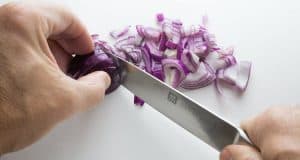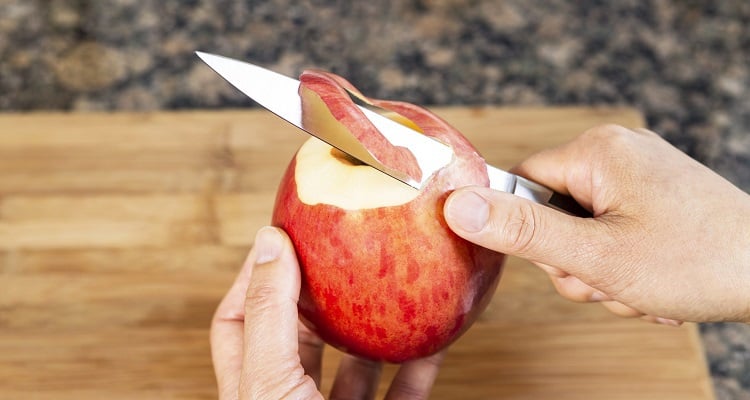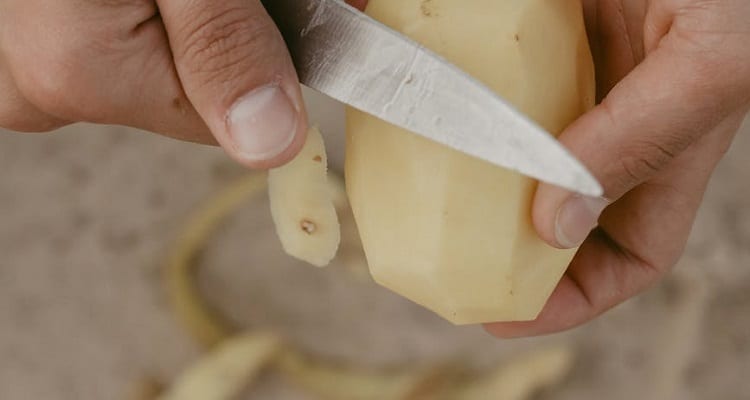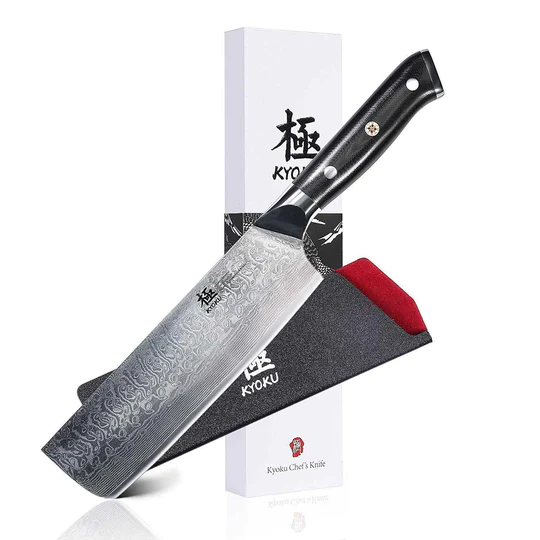


It’s easy to get mixed up between peeling and paring knives when choosing the right knife for your kitchen. The main difference? Paring knives have a straight, simple blade that handles lots of small jobs, while peeling knives use a curved blade made just for peeling fruits and veggies.
Picking the right knife makes prepping faster, and you will waste less food too.
A peeling knife, also called a tourné knife or bird’s beak knife, has a pointed tip that curves downward. This small knife is designed for removing skins quickly and neatly. The 2-3 inch curved blade lets you follow the curves of apples, potatoes, and fruit and veggies. Peeling Knives help you peel without hacking off too much flesh.
Paring knives have a straight, narrow blade, usually 3 to 4 inches long. The straight edge helps you make accurate cuts and trim seeds. The sharp point is also handy for piercing or scoring.

| Feature | Paring Knife | Peeling Knife |
|---|---|---|
| Blade Shape | Straight, pointed | Curved, “bird’s beak” |
| Best For | Peeling, coring, mincing, detailed work, slicing | Removing skin from round produce, decorative cuts |
| Versatility | High—handles many prep jobs | Specialized—mostly for peeling and shaping |
| Typical Length | 3–4 inches | 2–3 inches |
| Common Tasks | Coring tomatoes, trimming, mincing, sectioning citrus | Peeling apples/potatoes, garnishes, turning veggies |
Both knives have their place, but the paring knife is usually the more versatile one. Its straight blade works for slicing, peeling, coring, and mincing—just about any small prep job.
The peeling knife is the specialist, perfect for round produce and decorative work. It’s not made for slicing or tough jobs. If you want just one knife for lots of tasks, a paring knife is probably your best bet.

Paring knives come with a firm, slightly stiff blade, which gives you control for steady tasks like removing seeds or trimming fat. The blade edge is sharp enough for fine slicing and precision cuts. You can use a paring knife for all sorts of kitchen jobs, from cutting small meats to slicing cheese.
Peeling knives have thinner, more flexible blades. This lets the blade move around curves without gouging the food. The sharp tip starts the peel, and the rest glides under the skin. Because the blade’s thinner and more delicate, it’s best for soft foods and finer tasks.
The knife handle matters as much as the blade. Paring knives come with all sorts of handles including wood, plastic, and stainless steel. Wood feels classic and warm, while stainless steel is easy to clean and tough as nails. Some handles are textured or shaped for a better grip, which helps with those precise cuts.
Peeling knives usually have lightweight handles that fit right in your palm. Most use plastic or stainless steel to keep the weight down, so you can peel away for ages without your hand getting tired. The handle design often prevents slipping and keeps your hand steady while you’re working.
In both cases, you want a handle that feels balanced and secure, so you can peel, slice, or trim without worrying about losing your grip.
The right knife can save you time and frustration. Paring and peeling knives each have strengths that make them better for certain jobs.
A paring knife’s small, straight blade (usually 2.5 to 4 inches) is made for detailed work where you need control.
You’ll use a paring knife for peeling apples, deveining shrimp, coring tomatoes, or mincing garlic. The sharp tip pokes and slices in tight spaces where a big chef’s knife just won’t fit.
The paring knife is also handy for slicing strawberries, trimming mushrooms, or sectioning citrus, grab a paring knife. And it’ great for removing seeds from peppers or hulling strawberries.
Peeling knives have a curved, short blade and fit comfortably in your hand. The “bird’s beak” style is especially common. Some versions almost look like a tiny hook.

The curve helps you follow the shape of fruits and veggies, so you can take off the skin without losing too much of the good stuff. Use a peeling knife for apples, potatoes, kiwis, or any round produce.
These knives are also handy for shaping garnishes or trimming away blemishes. The curved blade gives you control for decorative or detailed cuts.
Blade material really matters for sharpness and durability. For most home cooks, stainless steel knives hit a sweet spot for price and performance. If you are using your knives daily, you might lean toward a forged blade for the extra toughness and comfort in the hand.
Paring and peeling knife blade options include:
Peeling and paring knives do jobs that bigger knives just can’t handle. Their size and blade shapes set them apart from the heavy-hitters in your kitchen, while blade material also plays a role in how well they work for different foods.
| Feature | Paring Knife | Peeling Knife | Utility Knife | Chef’s Knife |
|---|---|---|---|---|
| Blade Length | 3-4 inch straight | 2-3 inch curved | 4-7 inch | 6-12 inch |
| Best For | Slicing, trimming, detail | Peeling fruits, potatoes | Slicing, light prep | Chopping, dicing |
| Control | Very high | Very high | Good | Moderate |
| Versatility | High for small tasks | Specific to peeling | Moderate | High |
Kitchen utility knives land right between paring and chef’s knives. They are longer, so they handle mid-sized foods. But utility knives are just too big for jobs like coring apples or peeling garlic.
If you need to tackle bigger chopping, slicing, and mincing tasks the chef knife is ideal. But these knives are awkward for small, detailed jobs. This is also true if you’ve ever tried using a bread, steak, or carving knife for fiddly cutting tasks. These knife blades are just too long or the shape feels wrong.
You’ll reach for a paring knife when you’re slicing small fruits, popping out seeds, or trimming fat off meat. It’s also great for mincing garlic or chopping little veggies. The sharp point really helps with detail work.
You can peel with a paring knife. It’s not strictly for peeling, but it’s sharp and small enough for most skins. However, a peeling knife just feels better when you’re working with round produce.
Paring knives usually have a straight blade around 3–4 inches long, and they’re built for slicing, trimming, and sometimes peeling. Peeling knives have a shorter, curved blade that hugs the curves of fruits and veggies. The curved blade makes peeling round stuff a lot easier.
A paring knife’s longer, straight blade lets you slice, trim, and do a bit of peeling. A peeling knife is shorter and curved, so you can work close to the surface and make those careful, controlled cuts when peeling.
Go for a peeling knife when you need to strip thin skins off round fruits or veggies, like apples or potatoes. That curved blade really hugs the shape and gets the job done fast and clean.
If you find yourself handling lots of little kitchen jobs, a paring knife set gives you options for slicing, trimming, and those tiny detail tasks that pop up. On the other hand, an individual peeling knife shines if peeling fruits and vegetables is your main thing and you want a tool that just feels right for that job.
A paring knife comes in handy for anything that needs a little finesse. Think deveining shrimp, seeding peppers, coring strawberries, or slicing up garlic. It’s perfect for small foods and detailed cuts.
Peeling knives really shine when you are peeling potatoes, apples, or any round produce. That curve hugs the shape of your food, so you get the skin off without wasting what’s underneath. They’re also great for shaping veggies for garnishes or tourné cuts.
If you prep a lot of produce, a peeling knife can save you time and spare you some waste. For more intricate prep, a paring knife is an essential tool to have on hand.

Knife Buzz offers independent product reviews on a wide range of knives used in the kitchen, home, and outdoors. We make it easy for you to find the right knife at the best price.

Knife Buzz offers independent product reviews on a wide range of knives used in the kitchen, home, outdoors and at work.
The Knife Buzz Team are passionate about reviewing knives and we cater to a targeted audience that needs independent advice before purchasing.
KnifeBuzz.com may earn affiliate commissions on some pages of this website. Knife Buzz is a participant in the Amazon Services LLC Associates Program, an affiliate advertising program designed to provide a means for sites to earn advertising fees by advertising and linking to Amazon.com. Amazon and the Amazon logo are trademarks of Amazon.com, Inc, or its affiliates. When you click links to various merchants on this site and make a purchase, this can result in this site earning a commission. Other affiliate programs and affiliations include, but are not limited to, Google AdSense.